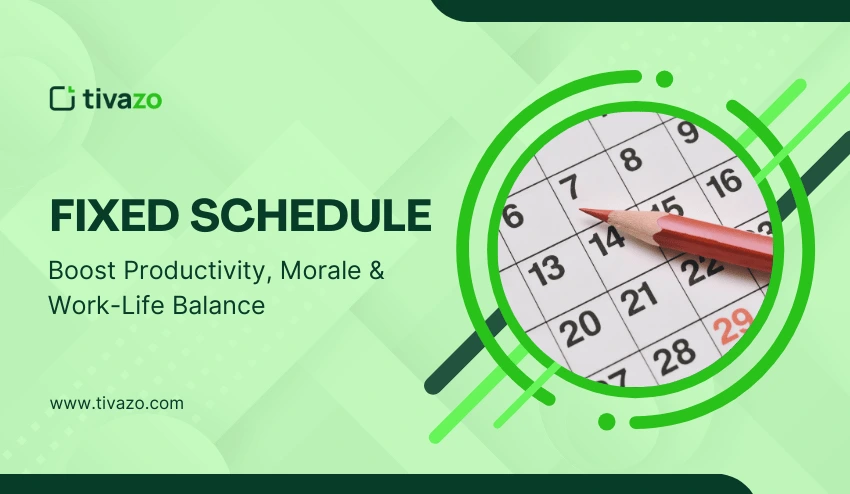In a world that is trying to be flexible, the good ol’ 9-to-5 schedule has been the backbone of many industries. However, with hybrid and remote working models allowing for much more flexibility, is a fixed schedule still providing productivity boundaries, or is it simply adding another layer of rigidity for a gasping work environment?
A lot of industries have shifted toward flexible hours, but fixed schedules are still providing a stable structure for the consistency and operational predictability needed in many workplaces. In this post, we will look at the benefits, difficulties, and tools to bring fixed schedules into your workplace in 2025.
Key Highlights:
- What is a Fixed Schedule in 2025
- Benefits of Fixed Schedules in Modern Work Culture
- Challenges of Fixed Schedules
- Examples of Fixed Schedules Across Industries
- Determine if a Fixed Schedule is Right for Your Team
- Balance Fixed Schedules with Employee Flexibility
What is a Fixed Schedule in 2025?
A fixed schedule is a work arrangement that requires employees to work and start/end their shifts at the same time every day. In 2025, fixed schedules typically align with the traditional 9-to-5 office jobs, part-time shifts, or fixed shifts for specialized job roles, such as those focused on health care, manufacturing.
Work arrangements that are flexible and new remote capabilities have tilted emphasis away from fixed schedules; however, they still have important advantages, and therein, liabilities for many industries and businesses that require consistent interaction with customers and work.
Benefits of Fixed Schedules in Modern Work Culture
Having a fixed schedule provides employees with highly active schedules/proflow and helps them plan their personal lives. Knowing when they work provides employees with greater control over family time, hobbies, time for recreation, and work-life balance.
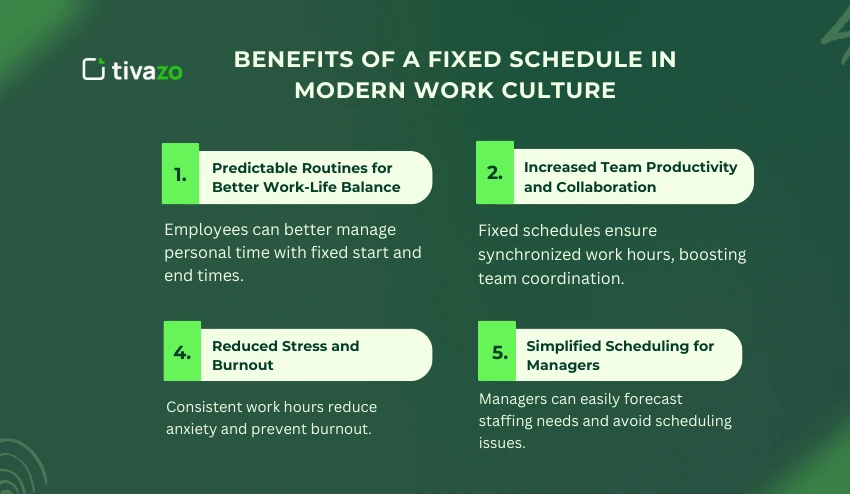
1. Predictable Routines for Better Work-Life Balance
Being aware of when their work days start and end allows employees to better manage their family time, hobbies, and rest.
Example: The typical 9-to-5 job allows two parents to plan some childcare and personal appointments to prevent them from being scheduled during work.
2. Increased Team Productivity and Collaboration
A fixed schedule ensures everyone is working in the same period, enhancing communication and collaboration and avoiding the disconnection associated with missed opportunities due to unavailability.
Example: When everyone works mostly the same hours, scheduling team meetings is not as difficult, and this leads to better decision-making and better ideas in the brainstorming process.
3. Reduced Stress and Burnout
Consistent and fixed hours remove the constant anxiety that comes with not being able to expect what your work hours will be, allowing for a greater mental peace.
Example: Employees are less likely to burn out when they know that they constantly have an expected work schedule to make their plans around, as opposed to just guessing with no defined shifting hours.
4. Simplified Scheduling for Managers
Having fixed schedules ensures that the manager can project a quarter ahead on staffing needs and make sure they aren’t either overstaffed or understaffed by looking back on previous projections.
Example: The manager can plan when they know peak times of the year are, such as planning for the holiday season in retail or before launching a product in technology.
Challenges of Fixed Schedules
While a fixed work schedule provides a level of consistency for employees, it can also create inflexible work for people with home responsibilities that can include young children or other forms of caregiving, or even school/education. It is the inflexibility in the fixed schedule that can turn employee satisfaction sour for people seeking gross flexibility in their workday.
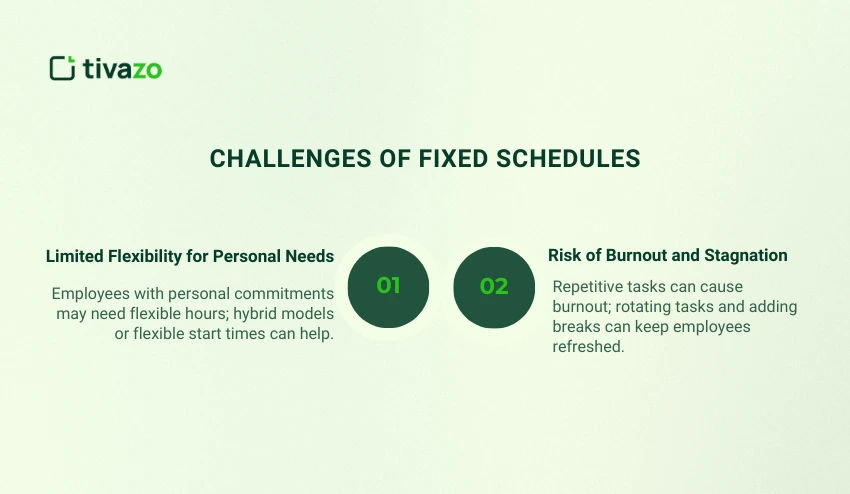
1. Limited Flexibility for Personal Needs
Some employees may be assigned a rigid work schedule – others may be able to adjust their schedule to meet their family and personal needs, such as being a caregiver or attending school.
Solution: Look into hybrid models, or flex start/end times for fixed schedule employees for personal needs. You can offer flexible components of a fixed structure without jeopardizing the fixed work structure.
2. Risk of Burnout and Stagnation
Repetition of both the tasks and the time of day can lead to boredom and/or creative fatigue.
Solution: Implement more breaks, rotate tasks, and allow employees to change their routines to avoid a state of burnout.
Examples of Fixed Schedules Across Industries
Now we can examine examples of fixed schedules across various industries.
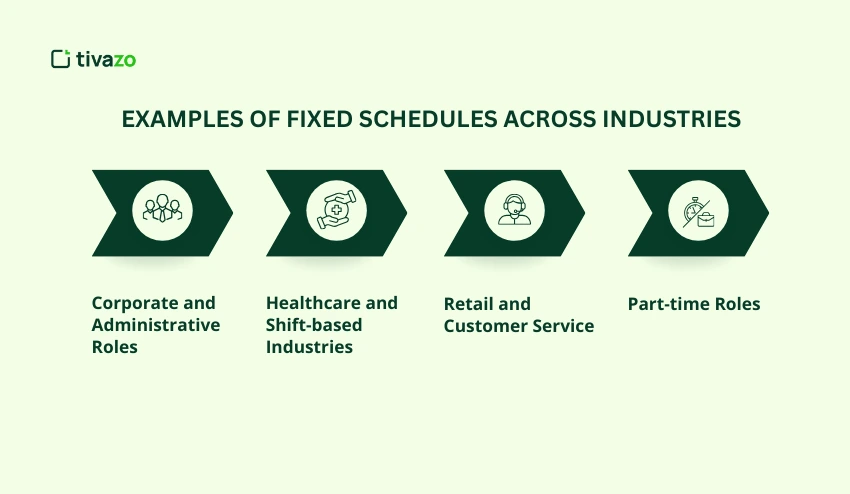
1. Corporate and Administrative Roles
The traditional 9-to-5 workday works especially well for office jobs where communication and meetings need to happen at scheduled times in order to stay connected. A fixed work schedule allows for coordination, communication, decision-making, and client communications.
- Benefit: Predictable communication and collaborators that are then easy to coordinate.
- Ideal For: office jobs requiring regular meetings.
2. Healthcare and Shift-based Industries
Healthcare utilizes fixed shifts (early, mid, late) for the purpose of providing 24/7 coverage. Having predictable schedules makes it easier to manage workloads and provide consistent service to patients.
- Benefit: Continuity in coverage through consistent delivery of patient care.
- Ideal For: Hospitals, clinics, and emergency services.
3. Retail and Customer Service
Retail stores schedule staff based on peak demand, frequently in the evenings or weekends. Fixed schedules ensure staff are available during peak demand times.
- Benefit: Better staffing at peak times.
- Ideal For: Retail, call centers, and customer service.
4. Part-time Roles
Fixed part-time schedules provide predictability for staff who do not work a lot of hours. Fixed part-time jobs are helpful for staff who have commitments in their personal lives, such as students or caregivers.
- Ideal For: Students, caregivers, and part-time workers.
- Benefit: Predictable hours with less total time in work.
How to Determine if a Fixed Schedules is Right for Your Team
There are several factors you need to weigh before you decide whether a fixed schedule is the right choice for your employees, and for you as the employer, such as:
Decision Checklist
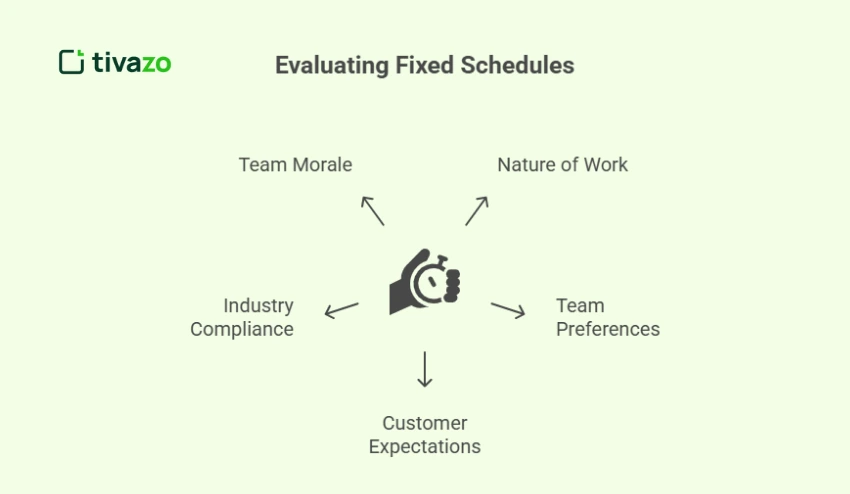
- Nature of Work:
- Does your work consist of routine or less-predictable tasks? If your work is routine, fixed schedules are a natural fit.
- Team Preferences:
- Do employees want structure or more flexibility? Conduct surveys to understand their needs.
- Customer Expectations:
- Are your clients expecting to receive services during fixed hours? You may have to have a fixed schedule for the roles that deal directly with customers.
- Industry Compliance:
- Are there requirements that deal with when an employee has to have a break, or even have mandatory rest periods, or marking time for overtime?
- Team Morale:
- You want to make sure the fixed schedule does not affect the morale of your team. Collect some feedback from an employee survey.
Implementing a Fixed Schedules: A Manager’s Guide
Planning and assessing business and employee needs will ensure a successful implementation of a fixed schedule. Managers can ensure an effective, equitable, and sustainable fixed schedule implementation by using a methodical approach. Here are some steps to help make your transition to a fixed schedule manageable:
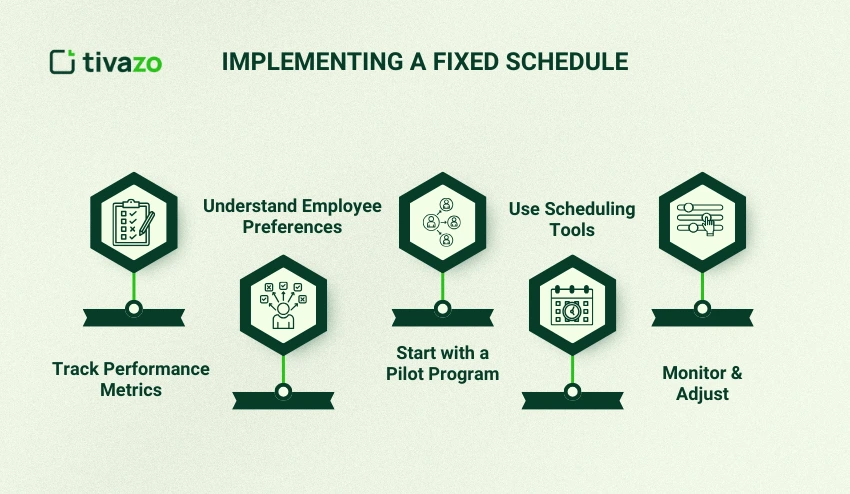
Step 1: Evaluate Business Needs
- Identify peak times:
- Pinpoint your business’s busiest times, including when customers demand your services, when due dates are closing in, or when products will be produced.
- Align schedule with needs:
- Adjust schedules so that fixed times align with your busiest times, so that your employees are working at full capacity and able to maximize productivity.
Step 2: Understand Employee Preferences
- Survey employees:
- Find out if employees are comfortable with having a fixed schedule. Understand how employees feel about hours and flexibility.
- Offer flexibility:
- If needed, consider hybrid schedules or flexible start/end times, while keeping core hours fixed.
Step 3: Start with a Pilot Program
- Test with a small team:
- Implement a fixed schedule, one department or group at a time, to limit disruptions to your organization.
- Track key metrics:
- Measure overtime, employee happiness, and productivity to gauge how effectively your fixed schedule is working.
Step 4: Use Scheduling Tools
- Automate scheduling:
- Use tools (like Tivazo) to “automate” the scheduling process, assign shifts, and approve time-off requests.
- Focus on higher-priority tasks:
- The less you have to do with employee schedules, the more time managers can spend on higher-priority items.
Step 5: Monitor & Adjust
- Adjust as needed:
- Use feedback and data insights to tweak the schedule and make improvements over time.
- Track performance:
- Continue to track employee performance, stress level, and overtime.
How to Use Technology to Streamline Fixed Scheduling
In today’s fast-paced work culture, the use of manual systems for managing fixed scheduling can cause errors, inefficiencies, and frustration. Using technology can make scheduling easy, while avoiding errors, ensuring compliance, increasing productivity, and increasing employee satisfaction.
- Automated Shift Assignment:
- Technology provides tools that automate scheduling while also reducing human errors.
- Time Tracking:
- Tools like Tivazo track employee hours, overtime, and breaks in real time. Time tracking can help ensure compliance while also increasing productivity.
- Compliance Management:
- Tracking employees’ time can automate employees’ compliance with labor laws, including breaks and rest periods.
- Real-Time Adjustments:
- You can easily adjust schedules for changes like employee availability, urgent requests, or increased customer needs.
How to Balance Fixed Schedules with Employee Flexibility
While fixed schedules help maintain order in a workplace, it is important to provide employees a certain amount of flexibility to accommodate their needs while achieving productivity from the work group.
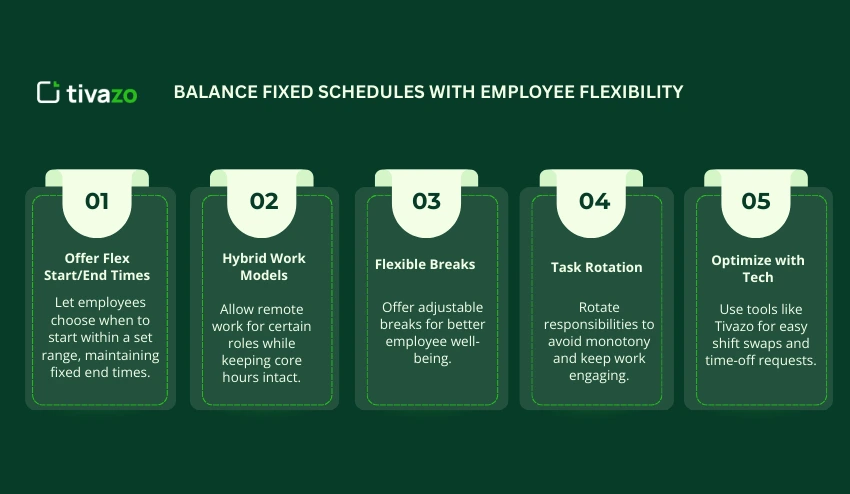
- Offer Flex Start/End Times
Employees should be permitted to alter their start or end times within a constrained range of time. For example, team members should be permitted to start work (within reason) anytime from 8.00 am to 9.30 am, while still clocking out at 5.00 pm. - Implement Hybrid Work Models
For positions where work can be done from home, consider allowing employees to work from home on certain days and still keep the core hours intact. - Design Flexible Breaks
In addition to flexible work hours, consider offering employees flexible lunch breaks or personal time that will help them take care of their well-being. - Encourage Task Rotation
For repetitive jobs, consider allowing employees to rotate responsibilities on occasion to keep things fresh. - Use Technology to Optimize Flexibility
Use technology, like Tivazo, to allow employees to adjust their schedules by swapping shifts or requesting time off, thus increasing their control over their schedule.
Final Thoughts: Is a Fixed Schedule Right for You in 2025?
In 2025, fixed schedules will still be an effective way to improve productivity and reduce stress, but they are not a universal solution. Whether you are a traditional office, healthcare, or retail business, weighing the costs and benefits will offer the best chance of understanding if fixed scheduling is appropriate for your business or not.
Why not try implementing a fixed schedule for your team? Observe how fixed scheduling affects employee productivity and morale, and adjust accordingly based on your team’s feedback.
